Leo, the Lion, stands high in the southern sky during the early spring. We visit some of the constellation’s brighter galaxy clumps then go asteroid hunting.
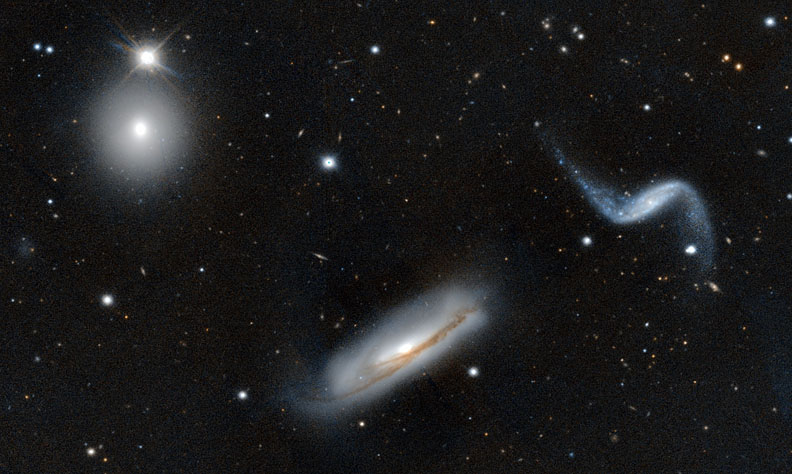
PanSTARRS DR1 / Aladin Sky Atlas
Whenever I watch a TV show or movie filmed in pre-COVID times I cringe at scenes featuring packed restaurants, bars and concert crowds. What used to be normal activities now seem so alien. Hopefully, that will change soon. There's no denying the right crowd engenders energy and excitement; gathering in groups to meet and share ideas is the essence of being human. I can't wait to feel that vibe again.
Likewise in the sky. When we come across a field thick with stars or spilling over with galaxies our thrill-meter goes up. Seeing three, four, or five deep-sky objects in the same view feels like reaching the summit with a sweeping view of peaks all around. Grander, really. With galaxy groups, we're looking at stellar congregations up to a million or more light-years across, separated by tens of thousands to millions of light-years. What magic frames so much space in the tidy circle of the eyepiece?
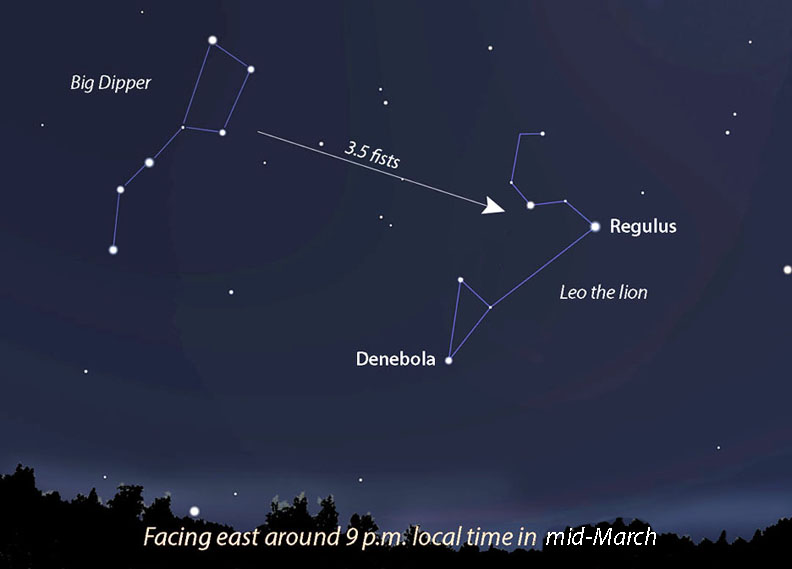
Stellarium
We're going to visit three such groups in Leo, all nicely placed in the southeastern sky around 10 p.m. local time in the latter half of March. The waxing Moon will interfere starting about the 20th but will get out the way again by month's end. My observations were made with a 15-inch reflector under Bortle 4 skies, rated as rural/suburban transition.
I deliberately selected brighter groups (and the brighter galaxies within those groups in some cases), so all of these should also be visible in an 8-inch telescope and a few in apertures as small as 6-inches.
When you observe these clumps, picture them as distant versions of our own Local Group. Each group is also a member of either the Leo I or Leo II galactic clouds, larger assemblages of galaxies at distances of approximately 35 million light-years and 75 million light-years, respectively. Like nested matryoshka dolls these fold into the Virgo Supercluster which is part of even vaster structure, the Laniakea Supercluster.
NGC 3227 Bunch — Leo II Group
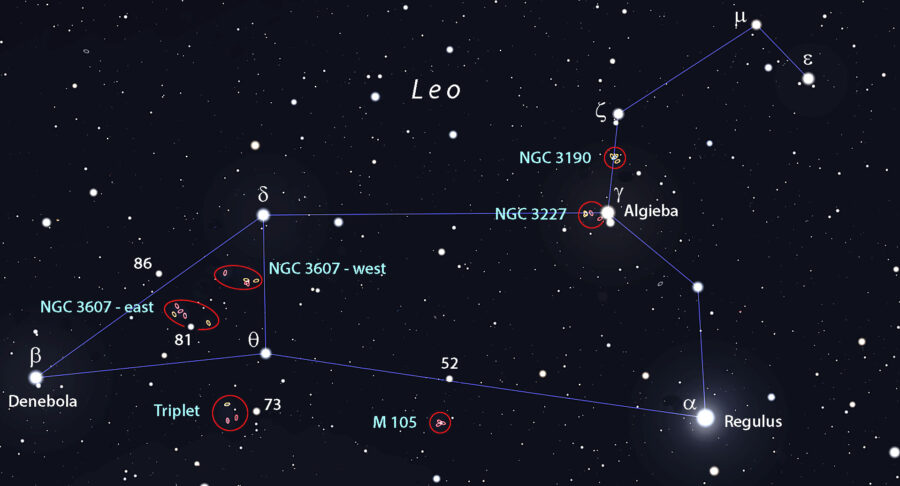
Stellarium with additions by the author
One of the easiest groups to find, the NGC 3227 bunch is located ¾° east of 2nd-magnitude Gamma (γ) Leonis, also known as Algieba. In a good sky, even a 6-inch scope will show two galaxies in contact — the spiral NGC 3227 and its companion NGC 3226, a dwarf elliptical. Also known as Arp 94 from astronomer Halton Arp's Atlas of Peculiar Galaxies, this interacting pair makes for a compelling sight. NGC 3227 is the brighter of the two at magnitude 10.3 and clearly elongated northwest-southeast with a prominent near-stellar nucleus.
Use magnifications north of 200× to appreciate its blazing intensity and to picture what lurks here, a supermassive black hole some 14 million times more massive than the Sun — more than three times the heft of the Milky Way's dark heart.
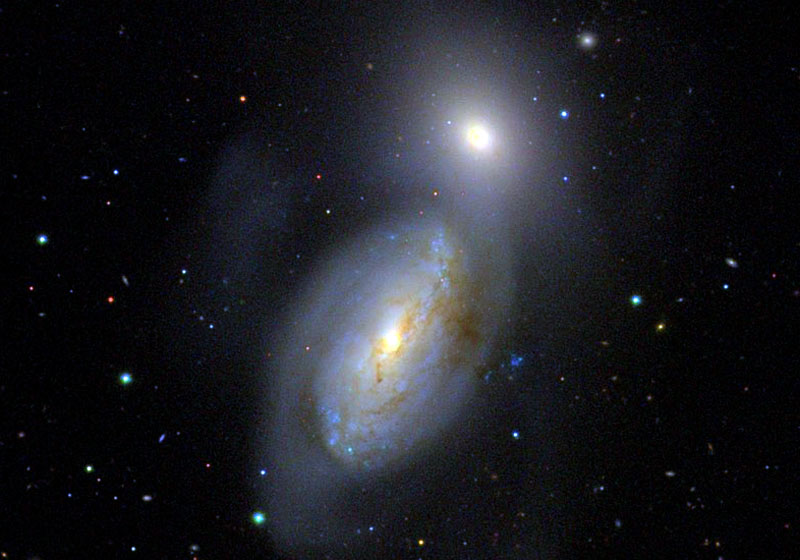
SDSS9 / Aladin Sky Atlas
NGC 3227 is a Seyfert galaxy with an active, quasar-like nucleus that flickers in X-rays on time scales of hours to months. Tidal interactions with NGC 3226 to the northwest have spawned blue knots of star formation within their common envelope. NGC 3226 is about half as large as its partner and a little fainter at magnitude 11.4. At first glance it appears round but reveals a faint, outer envelope angled northeast-southwest with averted vision. It also possesses a bright, nonstellar nucleus.
A third much fainter member of the group, NGC 3213 (magnitude 13.5, size 1.1′ × 0.9′), sits 33′ off to the southwest of the duo at the fringe of Algieba's glare zone. Use magnifications of 200× and higher to catch this midge. Another unrelated, more remote galaxy, NGC 3222 (magnitude 12.8, 1.3′ × 1.1′), lies 12′ west of the NGC 3226-27 pair. All four fit in a 1° field with room to spare.
NGC 3190 bunch — Leo I group
If NGC 3226-27 is your first stop you don't have to go far to find our next batch of furry galactic catkins. The NGC 3190 group appears just 2° north of Gamma (γ) Leonis on a line to Zeta (ζ) Leonis in a field peppered with bright telescopic stars ranging from magnitude 7.5 to 10.5. This tight clump of four galaxies spans just 17′wide, which means you can use magnifications of 200× or more and keep them all in the same field of view.
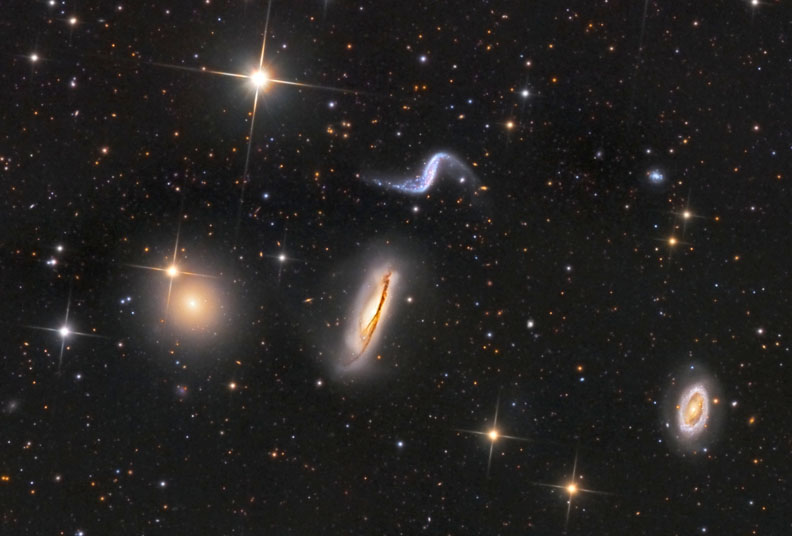
Stephen Leshin
The galaxy NGC 3193 (magnitude 10.9, 2.0′ × 2.0′) is a classic elliptical — round and fuzzy with a brighter core and near-stellar nucleus. A 9.6-magnitude star pins its northern border. While the spiral NGC 3190 (magnitude 11.1, 4.4′ × 1.5′) appears a tad fainter it was my favorite with an obviously elongated disk and a bright, extended nuclear region that swaddled a bloated, starlike nucleus. NGC 3185 (magnitude 12, 2.3′ × 1.6′) was a small, faint oval oriented northwest-southeast with a stellar core and slightly brighter inner disk.
I'd hoped to see the barred spiral NGC 3187's (magnitude 13.4, 3.6′ × 1.6′) wacky spiral arms, flung out on either side like a swing dancer, but this is a faint, diffuse object, and the best I could do was make out a misty, elongated disk tipped northwest-southeast at 257× with averted vision. Both NGC 3127 and neighboring NGC 3190 exhibited warped disks, evidence of tidal interactions common among galaxies in compact clusters.
NGC 3607 bunch — Leo II group
Located in the tail of Leo this group has two cores, one centered on NGC 3607 and the second on NGC 3684, some 2.7° to the southeast. NGC 3607, a spiral galaxy and the group's brightest and member at magnitude 9.9 and 4.7′ across, forms a tight trio with NGC 3608 (magnitude 10.8, 3.2′ × 2.6′) and faint NGC 3605 (magnitude 12.3, 1.5′ × 1.0′) in a north-south line. A fourth member, NGC 3626 (magnitude 11.0, 2.7′ × 1.9′), lies 50′ to the northeast.
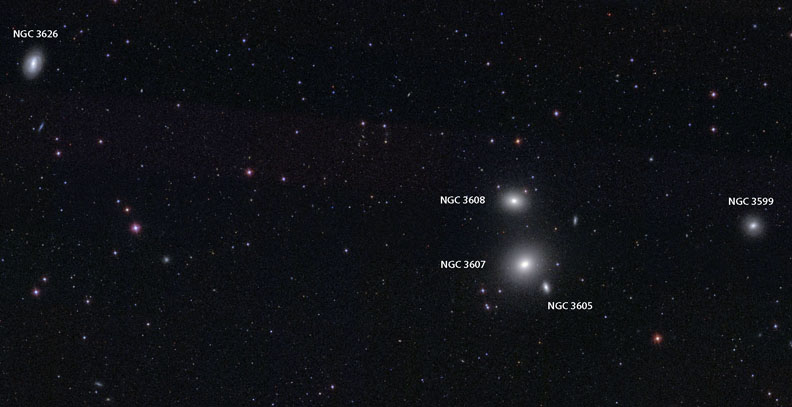
SDSS9/ Aladin Sky Atlas
NGC 3607 and 3608 resemble a pair of eyes at first glance, but NGC 3607 is clearly the brighter with a dense, luminous core and starlike nucleus set in a slightly elongated disk oriented northwest-southeast. The elliptical galaxy NGC 3608 is second dog here — a little smaller and fainter and extended east-west. Although NGC 3605, also an elliptical, looks like it belongs to the group due to its proximity to NGC 3607, it's actually much closer to us at 33 million light-years, making it a likely member of the Leo I group.
NGC 3626 (magnitude 11.0, 2.7′ × 1.9′), a true member, sits off by its lonesome 48′ northeast of the main bunch. It's a bright spiral extended northwest-southeast with a bright, stellar nucleus. While you're poking around you may also notice another faint galaxy sharing the field with NGC 3607-08, around 20′ to the west. This delicate puff with a brighter core is NGC 3599 (magnitude 12.0, 2.7′ × 2.1′), a spiral galaxy and another potential member of the Leo I group.
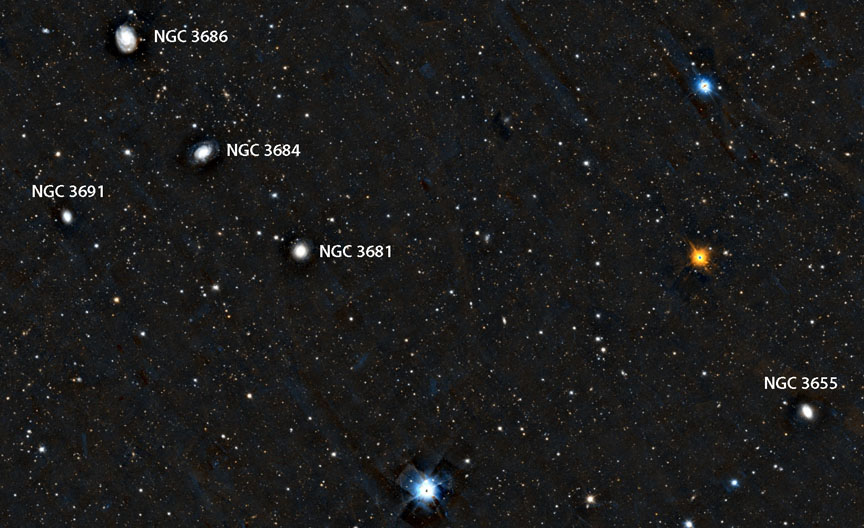
PanSTARRS DR1 / Aladin Sky Atlas
Moving east we arrive at the second core, composed of four rather dim galaxies that comfortably fit inside the field of view of my 142× Nagler eyepiece — three in an evenly-space northeast-southwest line with the faintest member, NGC 3691 (magnitude 11.8, 1.3′ × 1.0′), close by to the southeast. NGC 3686 (magnitude 11.3, 3.2′ × 2.5′), a barred spiral, is the brightest and largest member of this attractive group.
In good seeing at 257× I could discern a faint, extended nuclear region inside a mottled disk elongated northeast-southwest. A 15.5-magnitude star appears inside the barred galaxy's southern edge. The more tightly-wound spiral, NGC 3684 (magnitude 11.4, 3.1′ × 2.1′), displays a brighter core but lacks a stellar nucleus like its neighbor NGC 3681 (magnitude 11.2, 2.0′ × 2.0′) immediately southwest.
NGC 3691 was a dab of faint, uncondensed light. Farther afield, 1° west-southwest of the quartet, you'll find another group member, NGC 3655 (magnitude 11.7, 1.5′ × 1.0′) obviously elongated northeast-southwest with a bright, extended core dotted with a nonstellar nucleus.
If you're interested in additional galaxies in the region, such as the bright M105 group and the Leo Triplet, please check out my earlier blog and Howard Banich's article on page 18 of the April 2021 issue of Sky & Telescope. One of the challenges in observing these groups is taking the time to distinguish details in what looks like just another faint fuzzy. That's why fate placed galaxies in the spring and fall skies, when temperatures are conducive to spending more time at the telescope and the dreaded mosquitos are scarce.
Asteroid news
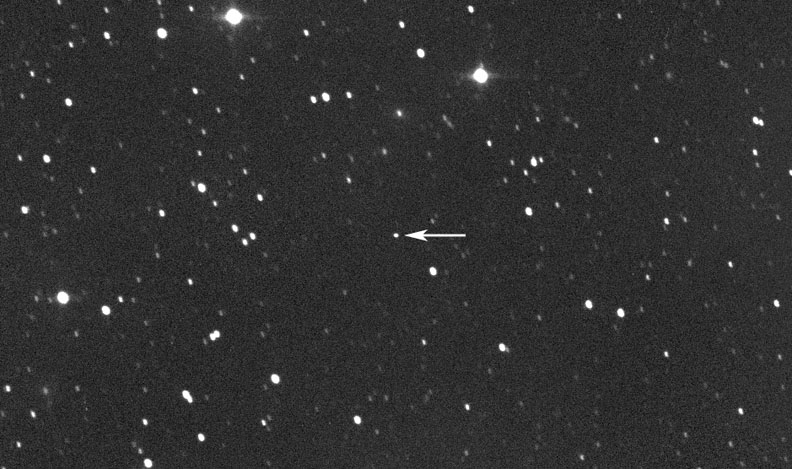
Gianluca Masi
On March 21st at 16:03 UT (12:03 p.m. EDT), the potentially hazardous asteroid 2001 FO32 will reach its minimum distance from Earth of about 2 million kilometers. Measuring between 440–680 meters (1,400–2,200 feet) across, this large object will become as bright as magnitude 11.7 on the morning of March 21st as it speeds across southern Sagittarius. Traveling at around 14′ per hour, you may even detect its motion in real time at magnifications of 200× or more. The asteroid quickly fades after the 21st but can be observed earlier on March 20th in Lupus at magnitude 12.0. For maps, visit astro.vanbuitenen.nl. Due to its southerly declination it's best visible from the southern U.S.
Then, on March 17th, observers in the southwestern U.S. will witness one of the best asteroidal occultations of 2021 when 10.7-magnitude 8 Flora covers a 7.2-magnitude star near the Hyades in Taurus. Your observations of the event will be of great value in determining details of Flora's shape and other parameters. The occultation will last up to 5 seconds with a 1.8-magnitude drop. It would normally be larger, according to David Dunham, with the International Occultation Timing Association (IOTA), but the star's 9.06-magnitude companion will remain visible during the occultation. You'll find finder charts and full details here.
 6
6
Comments
Anthony Barreiro
March 18, 2021 at 3:40 pm
"That's why fate placed galaxies in the spring and fall skies, when temperatures are conducive to spending more time at the telescope and the dreaded mosquitos are scarce."
The anthropic principle has an aesthetic dimension. 🙂
Visualizing groups, clusters, and superclusters of galaxies as nested Russian dolls is lovely and mind-expanding. Every group is the tiniest doll from its own perspective ... .
You must be logged in to post a comment.
Bob KingPost Author
March 18, 2021 at 8:21 pm
Hi Anthony,
Indeed it is!
You must be logged in to post a comment.
Howard Ritter
March 19, 2021 at 11:06 pm
Just a technical note – you referred to your Bortle 3 skies as "rural-suburban transition". I wish!
The Clear Sky Clock's color scheme uses two shades of blue to depict Bortle 3, and if you look at its light-pollution maps for anything east of the Mississippi, you'll see that there's little to no blue to be found in any of them, except in mountainous areas.
Bortle 3 is definitely deep rural, while the rural-suburban transition zone is Bortle 4/5. Or maybe worse – I live in suburban Perrysburg, Ohio, south of Toledo, on the edge of farmland, and the CSC rates my location as Bortle 7. I have to drive 30 or 40 miles into farmland to get to the upper half of Bortle 4, and two hours more to Ohio's darkest skies, the lowest quartile of Bortle 4.
Bortle 3? My entire state, neighboring Indiana, and then Illinois to the west, despite some vast stretches of farmland between small cities, have no Bortle 3 at all, and to the north, Michigan's blue patches are confined to the thinly populated upper part of the Lower Peninsula and the UP. The mainland part of my winter-home state of Florida enjoys Bortle 3 only in a few spots on its coastal margins and along Alligator Alley in the Everglades.
Bortle 3 is definitely a scarce commodity for most American stargazers, who only wish a drive to the nearest state park would take them there!
You must be logged in to post a comment.
Bob KingPost Author
March 20, 2021 at 3:51 pm
Hi Howard,
I'm so glad you wrote. My skies are "rural-suburban transition" as I wrote, but I accidentally
described them as Bortle 3 when they are Bortle 4. Thank you. Sad but true, Bortle 3 skies ARE a rare
commodity. Fortunately, to find them I don't have to drive nearly as far as you — 25 miles straight north will get
me there. But things are changing. My city of Duluth grows brighter by the year with winters the worst because of so much
reflected light from snow.
You must be logged in to post a comment.
Walter Clayton
March 22, 2021 at 6:34 pm
Thank You!
Thank You for boosting the NGC 3190 group! This is one of my favorite spring groups. If Leo is up and I have a scope set up, I'll at least take a peak at the group. I use 3185 as a test for sky quality. If I can see it in my 12.5in, it's a good night. If I see it well, then it's a great night.
So many folks just past this group up, this and NGC 2903, for the show pieces of the Messier objects. I find studying them much more rewarding.
Thank You again!
Walter Clayton
s/v Always Home
(currently in the Vero Beach Mooring Field)
You must be logged in to post a comment.
Bob KingPost Author
March 23, 2021 at 1:31 am
Hi Walter,
You're welcome! That was my aim — to suggest interesting groups that weren't too faint but are often overlooked. Thanks for sharing your own experience
observing the NGC 3190 group, also one of my favorites.
You must be logged in to post a comment.
You must be logged in to post a comment.